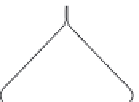Agriculture Reference
In-Depth Information
Hydroponics
Hydroponics (water culture) involves the growing of
plants in water. The term includes the growing in solid
rooting medium watered with a complete nutrient
solution, which is more accurately called 'aggregate
culture'. Plants can be grown in nutrient solutions with
no solid material so long as the roots receive oxygen
and suitable anchorage and support is provided.
drainage is minimal in recirculating systems.
X
reduced costs - these can apply depending on the
system as a result of labour reduction, reduced
growing medium costs and/or quicker turn-around
time between crops in protected culture.
Limitations include high initial costs of construction
and the controls of the more elaborate automated
systems. There are also different skills required for
maintaining the correct pH and nutrient levels in a
medium, water, that has no 'buffering capacity', that
is, small changes in the water can quickly bring about
a need for immediate correction - for example, pH
can fall rapidly overnight to harmful levels (compare
with changes that take years in soils before liming is
needed). Other disadvantages apply to the different
methods adopted.
Hydroponics
is the cultivation of plants in
nutrient solution without soils.
Active roots require a constant supply of oxygen, but
oxygen only moves slowly through water. This can be
resolved by pumping air through the water in which
the plants are grown (the same as the aeration of fish
tanks), a method that has been used in experimental
situations. Supplying oxygen to the roots is usually
achieved on a large scale by growing in thin films of
water, as created in the nutrient film technique (NFT)
or a variation on the much older aggregate culture
methods.
The advantages of hydroponic systems include:
X
water - there is a constant supply of available
water to the roots.
X
nutrition - accurate control can be achieved and
hence better growth and yield.
X
conservation of water - evaporation is greatly
reduced and loss of water and nutrients through
Nutrient film technique (NFT)
This is a method of growing plants in a shallow
stream of nutrient solution continuously circulated
along plastic troughs or gullies. The method is
commercially possible because of the development
of relatively cheap non-phytotoxic plastics to form
the troughs, pipes and tanks (Figure 15.3). There is
no solid rooting medium: a mat of roots develops in
the nutrient solution and in the moist atmosphere
above it. The nutrient solution is lifted by a pump to
feed the gullies directly or via a header tank. The ideal
flow rate through the gullies appears to be about 4
litres per minute. The gullies are commonly made of
disposable black/white polythene set on a graded soil
15
Nutrient
solution
Control
box
Clip
Polytheregully
Conductivity meter
Alarms
Dosing
pumps
pH meter
Acid
Flow regulator
Re-circulation pipe
Capillary matting
Roots growing out of
propagation pots
Polythene gullies
Firm graded support
or trays
Probe
Underwater
pump
Figure 15.3
Nutrient Film Technique. The nutrient solution is pumped up to the top of the gullies. The solution
passes down the gullies in a thin fi lm created by capillary matting laid in the bottom which spreads the stream of
water. The nutrient and pH levels in the catchment tank are monitored and adjusted as appropriate












































































































































































































